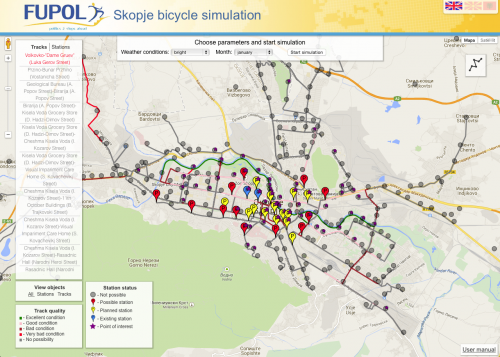Simulator determines most effective urban measures aimed at increasing bicycle use within cities

Universitat Autonoma de Barcelona researchers have developed a computer simulation model which helps city officials decide which improvements can be made to increase the number of bicycle users in the city. The model compares different actions and determines which sets of measures are the most adequate according to their impact.
Initially developed for the city of Skopje, Macedonia, the model allows foreseeing results and predicting the effect a set of actions will have on the number of bicyclists. Thanks to its application, the city of Skopje foresees an increase from the current 2.5% to 5%, a percentage typical of northern European cities, where bicycle transport is a consolidated option.
Among the improvements included in the programme are the adaptation of road surfaces, the construction of new roads to cover new itineraries, the creation of bike stations and rental points, and the modification of already existing stations.
In order to calculate the impact each possible change can have, the model takes into account the characteristics of the city's inhabitants, such as their motivation towards bicycles, the lack of motivation produced after conditions do not satisfy users, and the increase in motivation when neighbours also use bicycles.
"There is a difference between those who use their bicycle even if its raining, snowing or hot outside, and those who only use it if the road conditions are good and the weather is nice. This is the first time this type of model takes into accounts the percentage of each group of people according to their motivation and their preferences, and that makes it easier to predict the effects of each measure with grit precision" explains Roman Buil, researcher at the UAB Department of Telecommunications and Engineering Systems and creator of the model.
Given that municipal budgets are always limited, the model allows to personalise the measures to be implemented, such as deciding how many stations or paths to create, or adapting the road in a specific number of kilometres. Based on these initial conditions, the model offers, in percentage of users, the results of a list of combinations of different actions and determines which is the best combination to reach the objective.
It is not common for politicians to use computer models when making decisions, but this model has been very well accepted in all the cities in which it is being tested. UAB researchers have created similar models to be used in very different situations, such as optimising leisure options available on a mountain close to the city of Skopje; distributing the areas of an urban park to satisfy the preferences of a maximum number of users, in Zagreb, Croatia; determining the most adequate types of municipal facilities taking into account those living nearby (nursery schools, libraries, civic centres, parks, etc.), which is still to be implemented; as well as redistributing the industries of a large city to minimise environmental impacts, which is currently in trial mode in the Chinese city of Yantai.
Provided by Universitat Autonoma de Barcelona





















